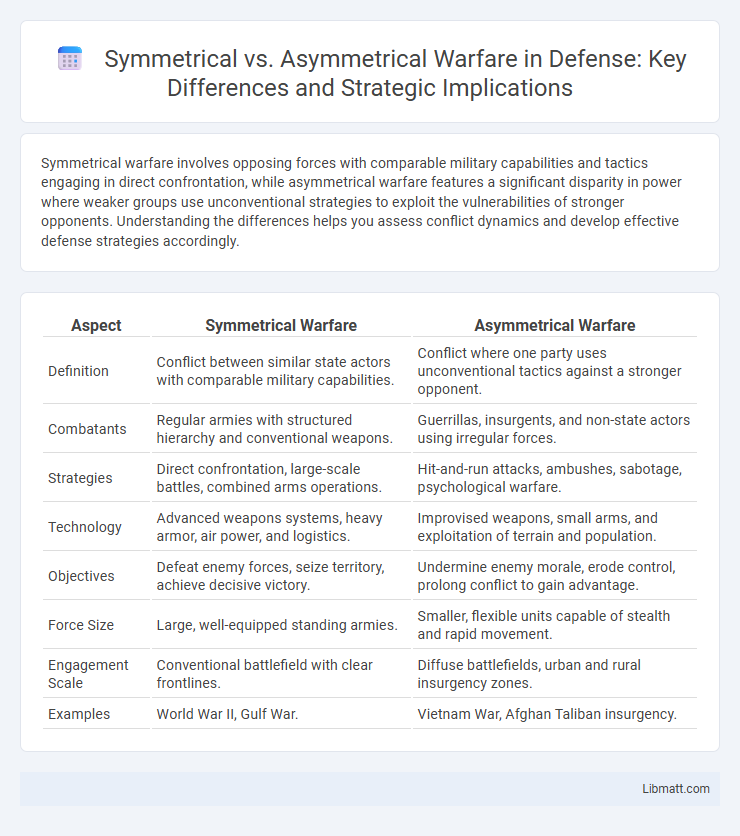Symmetrical warfare involves opposing forces with comparable military capabilities and tactics engaging in direct confrontation, while asymmetrical warfare features a significant disparity in power where weaker groups use unconventional strategies to exploit the vulnerabilities of stronger opponents. Understanding the differences helps you assess conflict dynamics and develop effective defense strategies accordingly.
Table of Comparison
| Aspect | Symmetrical Warfare | Asymmetrical Warfare |
|---|---|---|
| Definition | Conflict between similar state actors with comparable military capabilities. | Conflict where one party uses unconventional tactics against a stronger opponent. |
| Combatants | Regular armies with structured hierarchy and conventional weapons. | Guerrillas, insurgents, and non-state actors using irregular forces. |
| Strategies | Direct confrontation, large-scale battles, combined arms operations. | Hit-and-run attacks, ambushes, sabotage, psychological warfare. |
| Technology | Advanced weapons systems, heavy armor, air power, and logistics. | Improvised weapons, small arms, and exploitation of terrain and population. |
| Objectives | Defeat enemy forces, seize territory, achieve decisive victory. | Undermine enemy morale, erode control, prolong conflict to gain advantage. |
| Force Size | Large, well-equipped standing armies. | Smaller, flexible units capable of stealth and rapid movement. |
| Engagement Scale | Conventional battlefield with clear frontlines. | Diffuse battlefields, urban and rural insurgency zones. |
| Examples | World War II, Gulf War. | Vietnam War, Afghan Taliban insurgency. |
Introduction to Symmetrical and Asymmetrical Warfare
Symmetrical warfare involves opposing forces with comparable military capabilities, strategies, and resources engaging in direct conflict on relatively equal terms. Asymmetrical warfare features combatants with significant disparities in power, tactics, or technology, often relying on unconventional methods such as guerrilla tactics or terrorism. Understanding these distinctions helps you analyze modern conflicts and strategic military planning effectively.
Defining Symmetrical Warfare
Symmetrical warfare involves conflicts between opposing forces of roughly equal military strength, capabilities, and tactics, often engaging in direct combat with conventional weapons and strategies. It is characterized by structured battlefield engagements where both sides have comparable resources, technologies, and organizational frameworks. This form of warfare relies heavily on predictable military doctrines and force parity, contrasting sharply with the unpredictability and irregular tactics seen in asymmetrical warfare.
Understanding Asymmetrical Warfare
Asymmetrical warfare involves conflict where opposing forces have unequal military capabilities, prompting the weaker party to use unconventional tactics like guerrilla attacks, sabotage, and cyber warfare to exploit vulnerabilities in the stronger opponent. Understanding asymmetrical warfare requires recognizing these irregular strategies that prioritize agility, surprise, and adaptability over direct confrontation seen in symmetrical warfare. Your strategic advantage lies in anticipating and countering these unpredictable methods while leveraging superior resources effectively.
Key Differences Between Symmetrical and Asymmetrical Strategies
Symmetrical warfare involves opposing forces utilizing similar military capabilities and tactics, emphasizing direct confrontation and equal power projection. Asymmetrical warfare features combatants with unequal strength, where the weaker side employs unconventional strategies such as guerrilla tactics, sabotage, or cyber warfare to exploit the stronger opponent's vulnerabilities. Your understanding of these key differences is crucial for adapting strategies in modern conflict scenarios.
Historical Examples of Symmetrical Warfare
Historical examples of symmetrical warfare include the Napoleonic Wars, where European powers deployed large-scale, organized armies with comparable weaponry and tactics, emphasizing direct confrontations. The World Wars demonstrated symmetrical warfare through mass mobilization of troops and advanced technology like tanks and aircraft between nation-states. Battles such as the Battle of Waterloo and the Battle of Stalingrad exemplify symmetrical warfare's reliance on evenly matched forces engaging in conventional combat.
Notable Cases of Asymmetrical Warfare
Notable cases of asymmetrical warfare include the Vietnam War, where Viet Cong guerrillas used unconventional tactics against the technologically superior U.S. military. The conflict in Afghanistan highlighted how insurgent groups utilized knowledge of local terrain and hit-and-run attacks to counter coalition forces. Your understanding of asymmetric conflicts benefits from examining how non-state actors leverage irregular strategies to challenge established military powers.
Technological Impact on Warfare Types
Technological advancements have significantly shaped symmetrical warfare by enhancing the capabilities of similarly equipped state armies through precision-guided munitions, advanced surveillance, and cyber warfare. In asymmetrical warfare, technology empowers smaller, non-state actors with innovative tools like drones, improvised explosive devices (IEDs), and encrypted communications to counterbalance the superior resources of conventional forces. The evolving technological landscape continuously redefines strategic advantages and operational tactics in both symmetrical and asymmetrical conflicts.
Challenges and Advantages of Each Approach
Symmetrical warfare offers the advantage of predictable battlefield engagements and easier resource allocation due to comparable military capabilities, but it faces challenges in innovation and adaptability against unconventional tactics. Asymmetrical warfare leverages surprise, unconventional strategies, and local knowledge to offset technological or numerical disadvantages, presenting challenges in logistics, coordination, and sustaining long-term operations. Each approach demands tailored strategies to maximize strengths and mitigate vulnerabilities in complex conflict environments.
Contemporary Conflicts: Symmetrical vs Asymmetrical Tactics
Contemporary conflicts often feature a clash between symmetrical and asymmetrical warfare tactics, where state actors rely on evenly matched forces and conventional strategies while non-state groups utilize irregular methods such as guerrilla warfare, cyber attacks, and insurgency operations. Symmetrical warfare emphasizes balanced military power and direct confrontation, whereas asymmetrical tactics exploit vulnerabilities through unconventional means, making it more challenging for traditional armies to predict and counter threats. Your understanding of these differing approaches can enhance strategic planning and adaptiveness in modern security environments.
Future Trends in Warfare Dynamics
Future trends in warfare dynamics increasingly highlight the evolution from symmetrical warfare, involving evenly matched forces and conventional tactics, to asymmetrical warfare characterized by irregular strategies, cyber operations, and guerrilla tactics. Technological advancements in AI, drone warfare, and cyber capabilities empower smaller forces to exploit vulnerabilities in larger militaries, reshaping conflict landscapes. Your strategic planning must adapt to these hybrid threats by integrating intelligence, flexibility, and advanced technology to maintain operational superiority.
symmetrical warfare vs asymmetrical warfare Infographic

 libmatt.com
libmatt.com